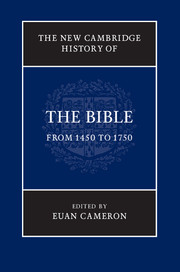Book contents
- Frontmatter
- Contents
- List of figures
- List of contributors
- Preface
- List of abbreviations
- Introduction
- PART I RETRIEVING AND EDITING THE TEXT IN EARLY MODERN EUROPE
- PART II PRODUCING AND DISSEMINATING THE BIBLE IN TRANSLATION
- PART III PROCESSING THE BIBLE: COMMENTARY, CATECHESIS, LITURGY
- PART IV THE BIBLE IN THE BROADER CULTURE
- PART V BEYOND EUROPE
- Afterword
- Select bibliography
- Select Bible bibliography
- Index
Afterword
Published online by Cambridge University Press: 05 August 2016
- Frontmatter
- Contents
- List of figures
- List of contributors
- Preface
- List of abbreviations
- Introduction
- PART I RETRIEVING AND EDITING THE TEXT IN EARLY MODERN EUROPE
- PART II PRODUCING AND DISSEMINATING THE BIBLE IN TRANSLATION
- PART III PROCESSING THE BIBLE: COMMENTARY, CATECHESIS, LITURGY
- PART IV THE BIBLE IN THE BROADER CULTURE
- PART V BEYOND EUROPE
- Afterword
- Select bibliography
- Select Bible bibliography
- Index
Summary
At the outset of the period covered by this book, the diverse forms of Christianity across the European and Mediterranean worlds had acquired distinct and in many respects deeply divided characteristics. The Western Latin mind had long been shaped by the Latin language, the appropriation of Greek and Arab philosophies in a Latinate garb and the dominance of the Vulgate Bible in the manuscript tradition. The social structures of the West reflected and also shaped its intellectual structures. A large, diffuse and diverse body of ‘clerici’ – the name designated both the learned and those living by the practice of religion – belonged to a theoretically international culture, one that was in principle (though not always in practice) institutionally distinct from the secular world that hosted and supported it.
The Eastern churches, with their greater diversity of languages and traditions, their more collegial and parallel structures of power based on the patriarchates and monastic communities, and unresolved historic divisions over doctrine, underwent a prolonged eclipse under the domination of the Ottoman Empire. Until near the end of the seventeenth century the Ottomans seemed to present an apocalyptic threat even to the churches of the West. Those Christian communities that did not become part of the Ottoman sphere of control were to some degree cut off from the rest of the Orthodox world. When a rising Russia looked for cultural resources around 1700, it looked west. There has been an unavoidable asymmetry in this volume between West and East. That is so largely because the processes that determined the structure of the book – the rise of critical textual scholarship, the Reformation divide in the Western churches, the rise of vernacular translations to challenge the ascendancy of the Latin text – were primarily Western phenomena between the fifteenth and the eighteenth centuries. The story of the Bible between c. 1450 and c. 1750 is the story of profound intellectual and cultural change shaped by the turmoil and upheavals of Western Europe.
After centuries in which thinking western Europeans thought unselfconsciously in Latin, from the fifteenth century onwards increasing numbers of adepts discovered the fascination of exotic languages.
- Type
- Chapter
- Information
- The New Cambridge History of the Bible , pp. 843 - 850Publisher: Cambridge University PressPrint publication year: 2016

